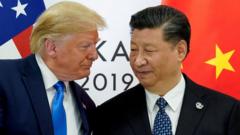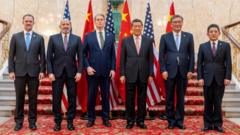The new agreement reached by the U.S. and China seems to merely revert changes made during the recent trade war, leaving many questioning its effectiveness and future stability.
U.S.-China Trade Talks: A Step Backward in Time

U.S.-China Trade Talks: A Step Backward in Time
A recent handshake agreement between the U.S. and China raises concerns about real progress amidst ongoing trade tensions.
In a significant yet uncertain turn of events, the United States and China have tentatively agreed to ease some of the escalating trade tensions that threatened to unravel their economic relationship. After two days of high-stakes discussions in London, officials reportedly reached a handshake agreement aimed at rolling back certain measures imposed in a trade clash that intensified in recent months.
Despite the optimism surrounding this truce, skepticism remains about its durability. Many analysts, including Myron Brilliant of the DGA-Albright Stonebridge Group, highlight the cyclical nature of these negotiations. "You escalate, you de-escalate," he noted, indicating that the parties involved may not actually progress further from their previous state.
Under the terms of the handshake deal, tariffs that have been a contentious part of the trade landscape are expected to remain intact for now. However, China is anticipated to lift restrictions on mineral exports, a move deemed crucial for various American manufacturers reliant on those resources. In turn, the U.S. may relax its limitations on technology exports, along with easing previous threats regarding the cancellation of student visas for Chinese nationals studying in America.
While leaders declare a temporary truce, the underlying question remains: can this agreement provide lasting stability, or is it simply a return to a status quo that existed before the most recent tensions were ignited in early April? The unfolding situation continues to be closely monitored by stakeholders on both sides as the global economic implications become apparent.






















